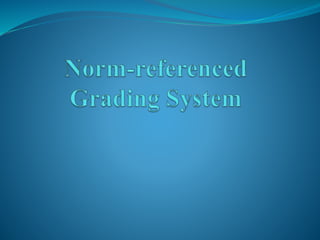
Norm reference grading system.ppt
- 2. Norm-referenced Grading System The performance of the student is evaluated relative to the performance of other students within a group. The performance of the student depends on the performance of the other student in the class.
- 3. Advantages It is very easy to use It works well for the courses with retention policies and it limits only few students to advance to the next level of the course. It is useful if the focus is the individual achievement of the students It is appropriate to a large group of students that is, more than 40 It does not encourage cooperation among the students The teacher easily identifies learning criteria – the percentage of students who receive highest grade or lowest grade.
- 4. Disadvantages The performance of a student is not only determined by his achievement, but also the achievement of the other students It promotes competition among the students rather than cooperation It cannot be used when the class size is smaller than 40. Not all the student can pass the given subject or course.
- 5. Criterion-referenced Grading System The students performance is evaluated against a certain criteria or standard. The criteria or standard is absolute in this grading system and it is also possible that all the student may receive the highest possible grade or all of them may pass the said test. It is also possible that all students may receive a failing grade if they will not reach the standard set by the teacher.
- 6. Advantages The performance of the students will not be affected by the performance of the whole class. It promotes cooperation among the students All students may pass the subject or course when they meet the standard set by the teacher
- 7. Disadvantages It is difficult to set a reasonable standard if it is not stated in the grading policies of the institution All students may not pass the subject or course when they do not meet the standard set by the teacher or the institution.
- 8. Types of Reporting System Different colleges and universities utilize symbols to describe and report the level of performance or achievement of their students. This can be numbers, percentages, letter grade equivalents and descriptions.
- 9. Example of Reporting Grades for Tertiary level Percentages Numbers Letters Descriptions 98 - 100 1.00 A+ Outstanding/Excellent 95 - 97 1.25 A Outstanding/Excellent 92 – 94 1.50 A- Very Good 89 – 91 1.75 B+ Very Good 86 – 88 2.00 B Good 83 – 85 2.25 B- Good 80 – 82 2.50 C+ Fair 77 – 79 2.75 C Fair 75 – 76 3.00 C- Passed Below 75 5.00 D Failed
- 10. Grading System of Public Elementary and Secondary Schools The Grading System that is being used is based on DepEd Order Number 33, series 2004, replacing the DECS Order No. 70, series 1998. The new grading system of DepEd is about giving grades that are mainly based on the students performance. Features Of the New Grading System 1. The lowest grade or the minimum performance standard for the students in public elementary and secondary schools is set at 75%. The lowest failing grade that may appear in the report card is 65%.
- 11. 2. 3. 4. 5. 6. The same standard shall apply to students in the Bridge Program. In assessing the learning outcomes, the construction of test items consist of basic terms 60%, moderately difficult or more advanced questions 30%, and higher order thinking skills 10%. Question in each category should have different weights. The test and non-test items should cover only materials actually taken up in the class. Grading System by subject shall follow the guidelines in Enclosure 1 and Enclosure 2 of DepEd Order 33, series 2004 The transmutation tables shall not be used in the computation of grades. Test scores shall be recorded as raw scores, totaled at the end of each grading period, and then computed as percentage. This is also known as the table of equivalence. The final grades shall be determined by averaging the marks for the four quarters. In the case of secondary level averaging across quarters shall be by subject only
- 12. 7. Promotion at secondary levels shall be by subject. A student shall be retained in the year level if he/she incurs failures of three units or more during the regular school year and is unable to make up for the failed subjects during the summer sessions. Retained students need to repeat only those subjects that they failed.
- 13. Salamat sa pagtao kan saindong atensyon!
